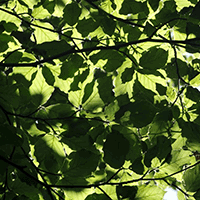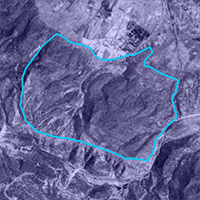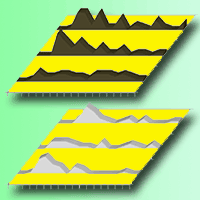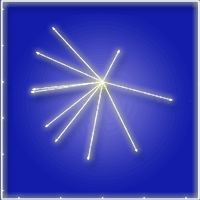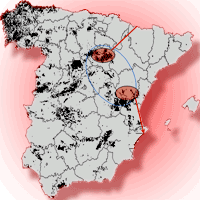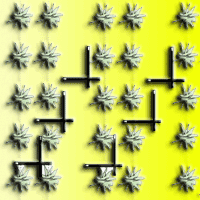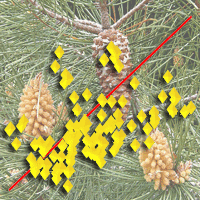
A simplified methodology for the correction of Leaf Area Index (LAI) measurements obtained by ceptometer with reference to Pinus Portuguese forests
Domingos Lopes (1) , Leónia Nunes (2), Nigel Walford (3), José Aranha (1), Carlos Jr Sette (4), Helder Viana (2), Carmen Hernandez (5)
iForest - Biogeosciences and Forestry, Volume 7, Issue 3, Pages 186-192 (2014)
doi: https://doi.org/10.3832/ifor0096-007
Published: Feb 17, 2014 - Copyright © 2014 SISEF
Technical Advances
Abstract
Forest leaf area index (LAI) is an important structural parameter controlling many biological and physiological processes associated with vegetation. A wide array of methods for its estimation has been proposed, including those based on the sunfleck ceptometer, a ground-based easy-to-use device taking non-destructive LAI measures. However, use of ceptometer in pine stands leads to the underestimation of LAI due to foliage clumping of this species. Previous studies have proposed a correction of biased LAI estimates based on the multiplication by a constant factor. In this study, a new method for obtaining a correction factor is proposed by considering the bias (the difference between the ceptometer measure and the reference LAI) as a function of the stand structural variables, namely the basal area. LAI data were collected from 102 sampling plots (age range: 14-74) established in Pinus pinaster forests all across northern Portugal. Data from 82 sampling plots were used for the adjustment of the LAI ceptometer correction model, while the remaining 20 plots were used for the model validation. The observed LAI ranged from 0.34 to 6.4 as expected from the large heterogeneity of the sampled pine stands. Significant differences were detected between LAI values estimated by ceptometers and LAI reference values. Different correction methods have been compared for their accuracy in predicting LAI reference values. Based on the results of the statistical analysis carried out, the new proposed LAI correction outperformed all the other methods proposed so far. The new approach for bias reduction proposed here has the advantage of being easily applied since the basal area is almost always available from forest inventory or can be inferred from remote sensing surveys. However, the bias correction model obtained is site-specific, being dependent on stand species composition, soil fertility, site aspect, etc. and should therefore be applied only in the study area. Nonetheless, the development of a correction methodology based on an allometric approach has proved to greatly improve LAI ceptometer estimations.
Keywords
Authors’ Info
Authors’ address
José Aranha
Departamento de Ciências Florestais e Arquitetura Paisagista, Universidade de Trás-os-Montes e Alto Douro, Quinta de Prados, 5000-801 Vila Real (Portugal)
Helder Viana
Escola Superior Agrária de Viseu, Quinta da Alagoa - Estrada de Nelas, Ranhados, 3500-606 Viseu (Portugal)
School of Earth Sciences and Geography, Kingston University, Penrhyn Road, KT1 2EE Kingston upon Thames (UK)
Agronomy School, UFG, Campus Samambaia - Rodovia Goi’nia / Nova Veneza Km 0 - Caixa Postal 131, CEP 74690-900, Goi’nia, GO (Brazil)
Facultad de Informatica UPV/EHU, Paseo de Manuel Lardizabal 1, 20018 Donostia-San Sebastián (Spain)
Corresponding author
Paper Info
Citation
Lopes D, Nunes L, Walford N, Aranha J, Sette CJ, Viana H, Hernandez C (2014). A simplified methodology for the correction of Leaf Area Index (LAI) measurements obtained by ceptometer with reference to Pinus Portuguese forests. iForest 7: 186-192. - doi: 10.3832/ifor0096-007
Academic Editor
Roberto Tognetti
Paper history
Received: May 17, 2011
Accepted: Oct 08, 2013
First online: Feb 17, 2014
Publication Date: Jun 02, 2014
Publication Time: 4.40 months
Copyright Information
© SISEF - The Italian Society of Silviculture and Forest Ecology 2014
Open Access
This article is distributed under the terms of the Creative Commons Attribution-Non Commercial 4.0 International (https://creativecommons.org/licenses/by-nc/4.0/), which permits unrestricted use, distribution, and reproduction in any medium, provided you give appropriate credit to the original author(s) and the source, provide a link to the Creative Commons license, and indicate if changes were made.
Web Metrics
Breakdown by View Type
Article Usage
Total Article Views: 60692
(from publication date up to now)
Breakdown by View Type
HTML Page Views: 50015
Abstract Page Views: 3308
PDF Downloads: 5720
Citation/Reference Downloads: 34
XML Downloads: 1615
Web Metrics
Days since publication: 4319
Overall contacts: 60692
Avg. contacts per week: 98.37
Citation Metrics
Article Citations
Article citations are based on data periodically collected from the Clarivate Web of Science web site
(last update: Mar 2025)
Total number of cites (since 2014): 11
Average cites per year: 0.92
Publication Metrics
by Dimensions ©
Articles citing this article
List of the papers citing this article based on CrossRef Cited-by.
References
Sunfleck Ceptometer - User Manual. Delta-T Devices LTD, Cambridge, UK, pp. 77.
Gscholar
Ecofisiología vegetal. Ediciones Omega, SA, Barcelona, Spain, pp. 531. [in Spanish]
Gscholar
Estimating net primary production in Eucalyptus globulus and Pinus pinaster ecosystems in Portugal. PhD thesis, Kingston University, London, UK, pp. 286.
Gscholar
A proposed methodology to estimate the carbon sequestration in a Pinus pinaster stand. In: Proceedings of the “Portuguese-Spanish IGBP Seminar 2004: Global Change and Sustainability”. Évora (Portugal) 15-17 April 2004. IGBP Publisher, Poster V.2.
Gscholar
Accuracy of remote sensing data versus other sources of information for estimating net primary production in Eucalyptus globulus Labill. and Pinus pinaster Ait. ecosystems in Portugal. Canadian Journal of Remote Sensing 35 (1): 37-53.
CrossRef | Gscholar
Statistical methods (6th edn). Iowa State University Press, Ames, Iowa, USA, pp. 503.
Gscholar

